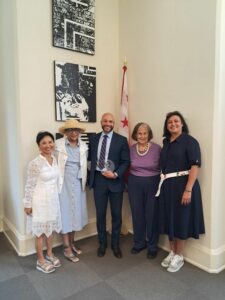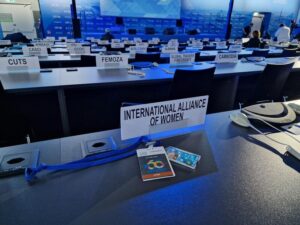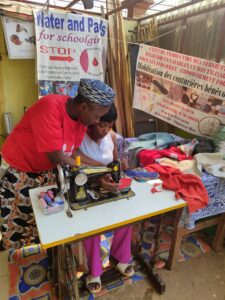 Introduction and short history
Introduction and short history
The Convention to End all forms of Discrimination Against Women (Vrouwenverdrag) is a human rights treaty, just like the International Covenant on Civil and Political Rights, or the International Covenant on Economic, Social and Cultural Rights. In response to the fact that these two covenants did not address the specific human rights problems facing women, it was finally in 1979, four years after the first UN Women’s Conference in 1975, that CEDAW was adopted by the UN General Assembly (UNGA). The Netherlands ratified the Convention in 1991. CEDAW has a ‘treaty body’, also called CEDAW, that supervises the implementation of the Convention by examining the country reports submitted to it every four years. Non-governmental organisations (NGO’s) may file shadow reports, which are also discussed by CEDAW.
In 1999 an Optional Protocol was adopted by the UNGA, which was ratified by the Netherlands in 2002. The Optional Protocol provides a Communications Procedure which allows individuals or groups of individuals to complain to the CEDAW committee.
Short History of CEDAW
Equality of rights for women is a basic principle of the United Nations. The Charter says that one of the purposes of the UN is to achieve international cooperation in promoting and encouraging respect for human rights and for fundamental freedoms for all without distinction as to, inter alia, sex. Through the UN Charter, the promotion of human rights, including the goal of equality between women and men, thereby became a contractual obligation for all Governments and the UN.
Despite the development of the Charter, women did not get to enjoy the rights that were supposed to be guaranteed to them. In response, the Commission on the Status of Women (CSW) worked out a number of important declarations and conventions. Between 1949 and 1959, the CSW put forward, among others, the Convention on the Political Rights of Women, the Convention on Consent to Marriage, Minimum Age for Marriage and Registration of Marriages. CSW considered these Conventions necessary as these were areas where the rights of women were particularly vulnerable. Beyond these specific areas, it was believed that women’s rights were best protected by the general human rights treaties.
The 1960s saw the emergence, in many parts of the world, of a new consciousness of the patterns of discrimination. The adverse impact of some development policies on women became apparent; for instance men were taught new agricultural techniques, even though it was women who worked on the land. Consequently, in 1974 the CSW decided to prepare a single, comprehensive, and internationally binding instrument.
The text of CEDAW[i] was prepared by working groups in the CSW during 1976 and was extensively deliberated on by a working group of the Third Commission of the UNGA.
Work was encouraged by the World Plan of Action for the implementation of the objectives of the International Women’s Year, adopted by the World Conference held in to finish its work by 1976, so that the Convention would be completed in time for the next Women’s Conference in Copenhagen in 1980. So it happened that at a special ceremony at the Copenhagen Conference on 17 July 1980, 64 States signed the Convention and two States submitted their instruments of ratification.
CEDAW
Why is it, in spite of the protection of the Declaration of Human Rights and the general human rights treaties, ICCPR and ICESCR, that women need their own Convention?
It is because women are discriminated against in every possible way, sometimes unintentionally, by deeply ingrained ideas about the roles of women and men and the unequal power relations between the sexes, generally known as ‘gender’. The word ‘gender’ doesn’t appear in CEDAW, it was introduced in the Platform for Action of the IVth Women’s Conference in 1995 in Beijing. But, with a similar purport, there is article 5 of CEDAW that obliges States Parties to take all appropriate measures:
a): ‘To modify the social and cultural patterns of conduct of men and women, with a view to achieving the elimination of prejudices and customary and all other practices which are based on the idea of the inferiority or the superiority of either of the sexes or on stereotyped roles for men and women;’
What is discrimination against women?
Article 1 of the Convention says that it means:
‘any distinction, exclusion or restriction, made on the basis of sex which has the effect or purpose of impairing or nullifying the recognition, enjoyment or exercise by women, irrespective of their marital status, on a basis of equality of men and women, of human rights and fundamental freedoms in the political, economic, social, cultural, civil or any other field.’
It took a long time for the Netherlands to ratify CEDAW. The reason for this is that the government first wanted to adopt legislation in conformity with the Convention and repeal discriminatory laws. For example, it took until 1985 before women could confer their nationality on their children on an equal basis with men. The law on equal treatment of men and women (WGB) of 1980 deals with discrimination in the workplace. And of course the revision of the Constitution (which came into force in 1983) brought us article I: ’discrimination because of … sex … is not permitted.’
All this happened in order to comply with article 2 of CEDAW.
The same article obliges the State to refrain from engaging in any act or practice of discrimination against women and to ensure that public authorities and institutions act in conformity with this obligation.
Even today there is a difference of opinion between the State and the CEDAW committee on the applicability of the Convention to local and provincial authorities. The Dutch government thinks it is not, the Committee says it is.
Another obligation of the State is to take all appropriate measures to eliminate discrimination against women by any person, organization or enterprise (2.e).
Temporary measures of ‘positive discrimination’ are permitted by art. 4.
I have already mentioned article 5. Not only does this call for doing away with stereotypes, it also asks the State:
b):to ensure that family education includes a proper understanding of maternity as a social function and the recognition of the common responsibility of men and women in the upbringing and development of their children, it being understood that the interest of the children is the primordial consideration in all cases.
This means that there should be no discrimination between boys and girls in the family.
The last article (6) of the general obligations is the suppression of all forms of trafficking in women and exploitation of prostitution of women.
Part II deals with the political rights of women: to vote and stand in all elections, to participate in the formulation of government policy and the implementation thereof, to hold public office and perform all public functions at all levels of government, and to participate in non-governmental organizations and associations concerned with the public and political life of the country.
Women should have the opportunity on equal terms with men to represent their Governments at the international level and to participate in the work of international organizations.
Article 9 says that States shall grant women equal rights with men to acquire, change or retain their nationality. In particular, they shall ensure that neither marriage to an alien nor a change of nationality by the husband during marriage shall automatically change the nationality of the wife, render her stateless, or force upon her the nationality of the husband. Women shall also have equal rights with respect to the nationality of their children.
Part III gives women the rights that cost the government money: education, employment, health, and economic and social benefits. There is a special article on rural women.
Articles 10, 11, 12, and 13 forbid discrimination in these fields, and they are pretty specific. The article on education not only demands equal conditions for teaching staff and school buildings, it also asks for measures to eliminate any stereotyped concept of the roles of men and women by coeducation, and in particular by the revision of textbooks and school programmes and the adaptation of teaching methods.
Sports and physical education are to be accessible for girls and boys. And access to specific information to help to ensure the health and well being of families, including information and advice on family planning, must be equal. At the same time, CEDAW asks for the reduction of female student drop-out rates.
High drop-out rates are due to a number of reasons. Apart from the reason of girls ‘being needed in the household’, drops-outs are often due to early or child marriage and child bearing. There are also seemingly mundane reasons, like not having toilet facilities in the schools, which can lead to the rape of girls by schoolmates. A persistent problem is rape by teachers.
The right to work is proclaimed in art 11 to be an inalienable right of all human beings, as is equal pay for work of equal value. In order to prevent discrimination on the grounds of marriage and maternity, the States Parties must take appropriate measures to prohibit dismissal on the grounds of pregnancy or maternity leave and discrimination in dismissals on the basis of marital status.
Maternity leave with pay and child-care facilities are necessary to combine family obligations and work responsibilities.
Health care (art.12) includes family planning. Appropriate services in connection with pregnancy, confinement, and the post-natal period are to be provided on a non-discriminatory basis.
Article 13 concerns measures in all other areas of economic and social life. Equality between men and women must be ensured in the right to family benefits, the right to bank loans, mortgages and all other forms of financial credit. and the right to participate in recreational activities, sports and all aspects of cultural life.
A special article 14 is dedicated to rural women in view of the significant roles which they play in the economic survival of their families, including their work in the non-monetized sectors of the economy. They should have a say in development planning, and a right to obtain all types of training and education. Family planning is also mentioned in this article.
Landownership is still a big problem for rural women, despite their right to equal treatment in land and agrarian reform.
Part IV deals with equality before the law. This is absolute. The States Parties agree that all contracts and all private instruments with a legal effect that are directed at restricting the legal capacity of women shall be deemed null and void.
Article 16 is about equality in marriage, the right to freely choose a spouse and enter into marriage with free and full consent. It gives the states the responsibility to ensure the same rights and responsibilities for men and women during marriage and at its dissolution, the same rights as parents, regardless of their marital status, the same personal rights as husband and wife, including the right to choose a family name, a profession and an occupation, the same rights regarding property, and most important of all: the same rights to decide freely and responsibly on the number and spacing of their children and to have access to the information, education, and means to enable them to exercise these rights.
The betrothal and marriage of a child shall have no legal effect. This article 16 is the one that, mainly from Islamic states, elicited the most reservations. Many other states did not accept these reservations because they were contrary to the meaning of the Convention.
The Committee (Part V)
For the purposes of considering the progress made in the implementation of the Convention there shall be established a Committee on the Elimination of Discrimination against Women. This CEDAW considers the reports submitted every 4 years by the States Parties (art 17,18). Nowadays the Committee meets in Geneva at the UN headquarters, where the Human Rights Council also meets. It has two weeks a year to discuss all the reports. (Other Human Rights Treaties don’t contain a time limit.)
Apart from suggestions to the States Parties on the basis of these reports (and of the shadow reports of NGO’s), the Committee may make General Recommendations.
CEDAW does not mention violence against women, a burning issue since the 90’s. This is partly remedied by a General Recommendation on the subject, and partly by the Istanbul Convention of the Council of Europe (CoE) on Violence against Women and Domestic Violence (2014).
Accession to this Convention is open to all States, not just the members of the CoE.
There are General Recommendations on women and AIDS, on female circumcision, and on disabled women. Others Recommendations focus on unpaid women workers in rural and urban family enterprises, and on the measurement and quantification of the unremunerated domestic activities of women and their recognition in the GNP.
Part VI has procedural articles.
Conclusion
Are women equal and treated equally to men?
There are a number of challenges regarding the Convention.
After almost 40 years CEDAW has not achieved universal ratification.
Many State Parties have entered reservations to important articles, thus not recognizing their duty to implement them and undermining the strength and the universal validity of the Convention.
Other States Parties refer to religion, culture, and to their national identity in order to keep discriminating against women on their territory.
Religious fundamentalism in its various forms threatens the universal validity of the Convention.
Many State Parties to the Convention still have to ratify the Optional Protocol, which allows the Committee to assist individual women and to develop a jurisprudence concerning the discrimination against them,
Even more State Parties still have to ratify the amendment to article 20 (1) of the Convention which lifts the restriction on the meeting time of the Committee. This restriction is a unique feature in the now seven UN human rights treaties and constitutes a discrimination against the Convention in itself and against the women which it protects.
The future
The Sustainable Development Goals (SDG’s), proclaimed last year, have as goal 5:
Achieve gender equality and empower all women and girls.
Gender equality is not only a fundamental human right, but a necessary foundation for a peaceful, prosperous, and sustainable world.
The CSW discussws this Goal at its session in March of this year.
There is no reason for optimism however; in the draft Agreed Conclusions of CSW, it says that no country has yet achieved gender equality.
Women keep advocating for equality!
This article was first published here


